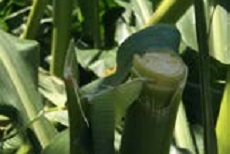
Jun 30, 2020, 9:25 AM
Green Snap and Yield Loss
When the weather makes a turn for the worst and storms roll through during the summer months, many farmers cringe as they hear the strong winds. They are worried about the crops and hope their fields are not impacted by the high wind events. Sometimes, if the conditions are right, their corn experiences significant stalk breakage, referred to as green snap.
Factors to Consider:
Green snap typically occurs when the stalk is rapidly elongating, resulting in brittle cell walls. If these brittle stalks are hit by strong winds, typically we see the stalk break, usually at a node. Green snap typically happens between the V8 growth stage and tasseling. The stalk is taller, and the leaf surface area increases which makes it easier for the wind to catch the plant and break the stalk. All corn hybrids are at risk of green snap, but hybrids vary dramatically in their tolerance to green snap.
 Factors influencing green snap and its severity:
Factors influencing green snap and its severity:
- Post emergence herbicide application, such as growth regulator types of herbicides, increase the risk of green snap
- Timing and severity of the storm
- Growth stage of the corn during the wind event
- Rapid growth conditions such as warmth, moist weather, high fertility rates (especially nitrogen), high planting populations and conventional tillage
- Conditions prior to the storm, such as soil moisture and temperature
- Field characteristics including topography, soil type, row spacing and row direction relative to the direction of the wind
- Hybrid genetic differences
Action Plan:
- The best way to avoid green snap is to choose a hybrid that has a strong genetic background and is more resistant to green snap
- Plant a range of maturities so your crop won’t all be in the same stage of growth at the same time.
A good rule of thumb to follow is:
• 50-55% of your hybrid selection should fall into the mid-maturity range for your area
• 15-20% of your hybrids should fall into the early maturity range
• The remaining 25-35% of your hybrids should fall into the full-season range - Manage applications of growth regulator herbicides to reduce the risk of injury
- Plant seed at the proper depth. This will help avoid shallow nodal root development
- If green snap has occurred in your fields, use the table below to determine your yield loss. This table shows the correlation between the percentage of the stand being reduced and the expected yield loss. The more stalks that have snapped, the greater the yield loss:
Percent yield reduction associated with differing levels of green snap at three different timings (average of three years of research, 2015-2017), Prosper, ND
Source: North Dakota State UniversityPlants
SnappedSnapped at
V12 StageSnapped at
V15 StageSnapped at
V18 Stage25% 11% yield loss 10% yield loss 14% yield loss 50% 14% yield loss 23% yield loss 30% yield loss 75% 27% yield loss 37% yield loss 48% yield loss - If you experience green snap, contact your crop insurance providers to explore the opportunities that they may provide regarding your situation
Summary
Green snap is a common problem that producers face after strong winds. Be ahead of the storm and consider a corn hybrid that has strong green snap tolerance. Contact Legend Seeds to select the corn hybrid that is right for your acre.

